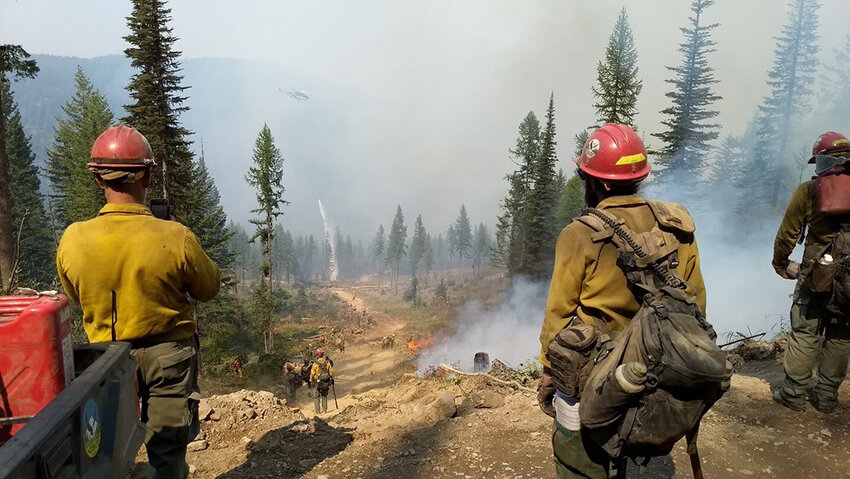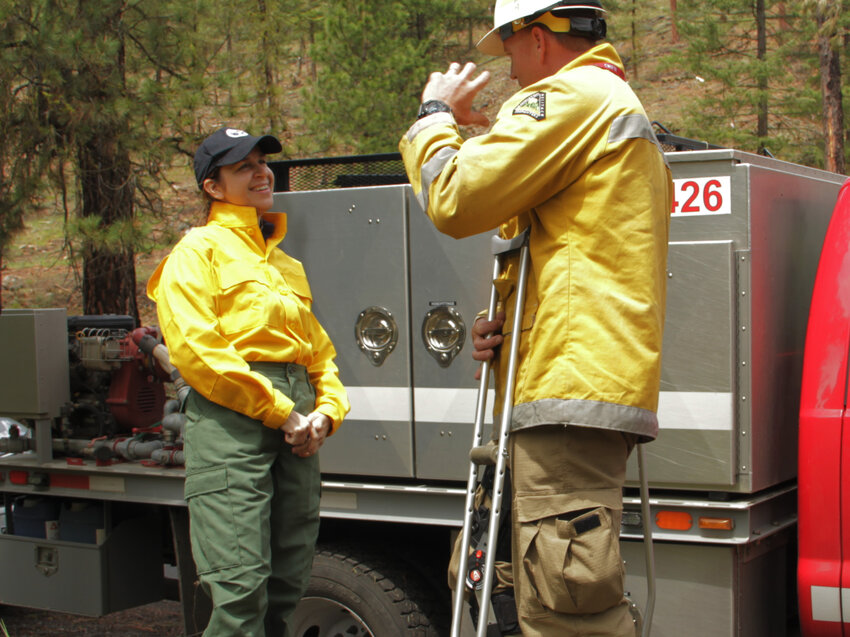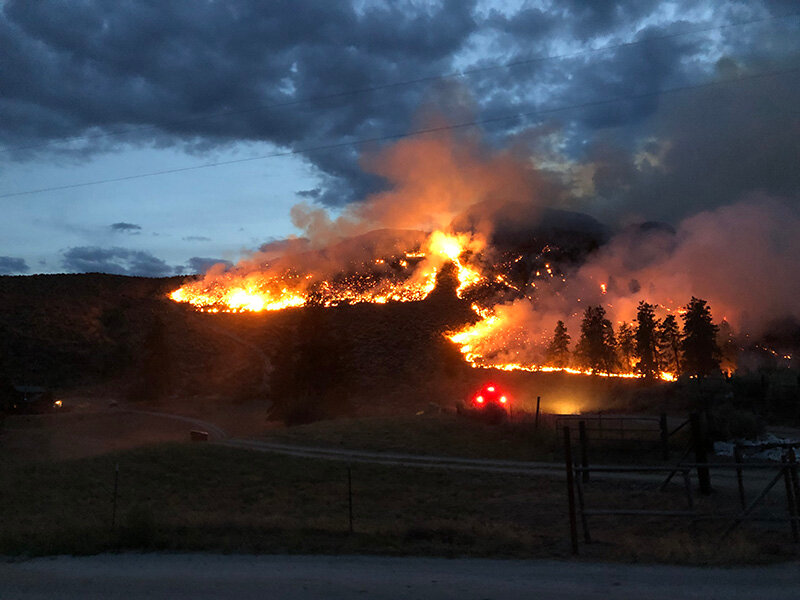 Firefighters in Boyds, Washington watch as a helicopter drops fire retardant on a wildfire on the Columbia River. Photo courtesy U.S. Forest Service
Firefighters in Boyds, Washington watch as a helicopter drops fire retardant on a wildfire on the Columbia River. Photo courtesy U.S. Forest ServiceAs commissioner of public lands, Hilary Franz oversees the Washington State Department of Natural Resources (DNR). Franz developed a wildfire and forest health funding bill that went into effect August 25. The bill will provide $125 million every two years to boost wildfire response, accelerate forest restoration and support community resilience.
We spoke with Franz just before Labor Day weekend — the middle of fire season — while the DNR prepared for what they hoped would not be a repeat of 2020. Seventy percent of the acres burned last year in Washington were from wildfires that started over Labor Day weekend.
 Commissioner of public lands Hilary Franz (l.) talking to firefighters.
Commissioner of public lands Hilary Franz (l.) talking to firefighters.Mount Baker Experience: We’re getting toward the end of Washington’s fire season, how are you feeling?
Hilary Franz: First, I would say right now, I’m feeling cautiously optimistic that we will get through the season. While we will have a lot of exhausted firefighters and a lot of overwhelmed communities, with the number of evacuations and the number of fires that were threatening them, we will hopefully have a very safe fire season, even with the daunting number of fires, and how long this fire season has had us go, with no break since July.
How has this year compared with past years?
This year, we have 640,000 acres already burned and over 1,700 fires. Last year, over 800,000 acres burned in more than 1,600 fires. Our landscape is extremely hot and dry. On both sides of the Cascades, we haven't had much moisture, the majority of the state is in a drought. Our firefighters have been going since July. We have fortunately been able to keep under 10 acres burned in a majority of the 1,700 fires as a result of our initial attack and amazing work by firefighters.
What does your fire season look like?
Well, I mean, my fire season starts in March. Even before March, we are looking out at what the year is going to look like based on weather. Each year, our fire seasons have been getting more significant. In fact, six out of the last seven years have been catastrophic fire seasons, where every year is worse than all the years before. And this year is now worse than last year’s.
But we start as early as March identifying what kind of resources we're going to need. Are we going to need more air resources or any more firefighters? This year, we recognized the drought that our state and most of the western United States was experiencing. We knew fires were going to be prevalent in many other states, and that we needed to take action immediately to have resources under exclusive control.
So we spent much of April, May and early June — even while pushing the legislature for more funding — securing more resources, getting those contracts in place for exclusive use of them or having to beg, borrow and steal them from elsewhere, and obviously training our firefighters.
When the fire season began in July, most of my work is making sure that the resources are being prepositioned. Resources are being leveraged, especially air resources. That we are getting on those fires as quickly as possible on initial attack. We don't have any sort of barriers that are administrative, whether it's between our federal partners or state partners or local partners.
How will your new funding bill, House Bill 1168, impact the state’s response?
That will have a significant impact in three ways based on the way I designed the bill.
The first is wildfire response. We will have the critical resources we need before fires even start, so we can get on those fires as quickly as possible and contain them. This bill will secure over $70 million for us to have available for wildfire responses. This means we'll be able to train and hire 100 full time firefighters to add to our over 70 that we have now. Firefighters are key when they are trained and available. It will also increase the number of critical air resources we have.
 A wildfire burning on a hillside in Washington. Photo courtesy of Washington state Commissioner of Public Lands' office
A wildfire burning on a hillside in Washington. Photo courtesy of Washington state Commissioner of Public Lands' officeThe second is forest health. The reason we have such catastrophic wildfires is forests are dying. In eastern Washington alone we have 2.7 million acres of forests that are dying, leading to larger fires. We are seeing the similar dying off of forests on the west side of the state. Our forests are capable of fighting fire on their own if they’re healthy, if they're not weak, if they're not dead, if they're not diseased. The problem is they are so sick that all it takes is a spark and where 100 acres might have burned before, we now have 100,000 acres that are burning. And we have that not just in one or two locations, but all throughout the state.
The funding from 1168 will enable us to achieve our 20 -year forest health plan, helping restore the health of forests; private land forests, state forests, federal forests and tribal forests. With the goal that we can get in there, remove the dead, dying or diseased trees, and enable the healthier trees to get healthy so they can withstand and fight fire on their own.
The third thing is community resilience. We have over 2.2 million homes in Washington state at risk of being destroyed by a wildfire. That number’s growing every single day due to Covid-19, and more and more people realizing they can live and work from anywhere.
Specifically, Malden last year was a very big eye opener, an eye opener for myself as well as many people in the state. We have communities with very high risk that can completely be destroyed in just a few hours. In that case, 80 percent of the homes were destroyed. That community wasn't even in the top 30 most at risk of wildfire in the state. When you walk that community and you saw the destruction, house after house burned to the ground with just the chimney standing. Amongst all that rubble there was a home completely untouched, because they had taken steps to create defensible space around their home. We have the ability to give every homeowner the power to protect his or her home, even as we have a growing wildfire risk.
How can the average resident help the state in wildfire response?
First and foremost, they can do it starting today. Humans cause 90 percent of our fires. So the first thing people can do is be one less spark out there.
Those on the west side of the state, if you're going east, know how hot and dry and parched that landscape is, and how one spark can lead to a catastrophic fire in just a matter of a few hours. In addition to that, on the west side of the state, we're seeing more and more fires — 20 percent more than last year. With the majority of the state being in a drought, the landscape on the west side is just as dry and parched and at risk of fire.
Please follow the burn ban. No campfires, no debris pile burns. Don't park on dry grass. Check your chains on your trucks and your car. Make sure if you're out with an ATV or motorcycle, you don't create a spark out on the landscape. And we're urging everyone to truly make this the safest Labor Day weekend possible not only for themselves, but for our firefighters, who are exhausted. They are tired. They haven't had a break since July 1. x